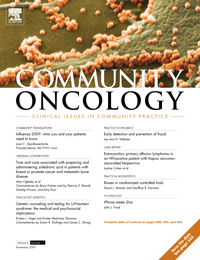Thinking of launching an oncology journal? You may have missed a profitable window.
The cancer category, which in the past has been more resilient than other medical-publishing segments, this year has waned along with most of professional media. And while publishers say factors like the economy and uncertainty due to M&A activity and healthcare reform are behind the decline in ad sales/pages, the drug-development pipeline which has historically powered oncology journals’ success has also shown signs of fatigue.
For the first 10 months of the year, the amount spent on display ads in cancer-related titles overall had declined to $32 million from $36.5 million, a 12.5% drop, according to PERQ/HCI, a firm which tracks medical-publishing performance. Ad pages are down 9.8% over the same span.
Dan Kim, president and publisher of Elsevier Oncology, attributed the drop in oncology advertising to “a feeling in pharma and broadly in healthcare…that all of a sudden the margin in healthcare will shrunk due to reform.” Community Oncology, one of three cancer-related titles published by Elsevier’s International Medical News Group, was down nearly $400,000 in ad sales compared to the first 10 months of 2008—a 39% decline, PERQ/HCI data show.
Significant declines are prevalent across the category. As of October, the Journal of Oncology (JCO), the largest cancer journal by sales, is down 11% in dollars and nearly 16% in pages vs. the first 10 months of 2008, according to figures cited by its publisher.
“We speculate that several factors may be contributing to this decrease in advertising including aging products with reduced marketing budgets, slow delivery of new products to market and the general downturn in the US economy,” a JCO official told MM&M.
Some publishers have bucked the trend. Ad dollars for Slack’s Hem/Onc Today were up 13.4% year-to-date October vs. last year, while during the same period Haymarket Media’s American Journal of Hematology/Oncology had risen 14.4% after picking up some new advertisers.
These examples are not the norm, however, and stats suggest the oncology segment may be losing some of its dominance: it posted less than $30 million in ad sales as of September vs. about $34 million during the same period two years ago.
All medical specialty journals, except for urology, posted off years through the first three quarters of the year. But the decline in oncology is significant considering that, at least since 2007, the category has commanded the highest ad dollar total among all specialties. This year the next closest segment, cardiology, has only half of oncology’s sales volume.
M&A activity, Kim said, has prompted some pharma companies to defer ad spending until next year in anticipation of management-structure changes. Kim cited the “risky nature of R&D” as another factor.
Indeed, during the first part of this decade, the FDA approved drugs that changed cancer treatment, such as Avastin, Tarceva and Gleevec. The second half of the decade has not matched the first in terms of innovation. That’s not for a lack of effort. JCO research shows 27 drugs in Phase III trials for breast cancer, 30 for non small-cell lung cancer and 16 for colorectal cancer, among others.
“On the brighter side,” Kim said, “when you look at any other therapeutic area, oncology stands alone in terms of new products and promise and the future pipeline being as aggressive or robust as it could be.” Some publishers think that that promise may start to pay off again and that the oncology sector is poised to rebound.
“While 2009 started off slowly, we have observed a turnaround in the last quarter driven largely by new product launches,” the JCO official added. “With these launches, JCO is seeing an increase in the size of the ad units, which is a reversal of the trend in recent years. We are hopeful that professional ad support will trend upward in 2010.”
Kim also said he believes cancer journals may have ridden out a period of marketer indecision due to pending pharma reorganizations. Now that the Pfizer/Wyeth and Merck/Schering-Plough mergers are complete, “We kind of know where things are more than before.”








